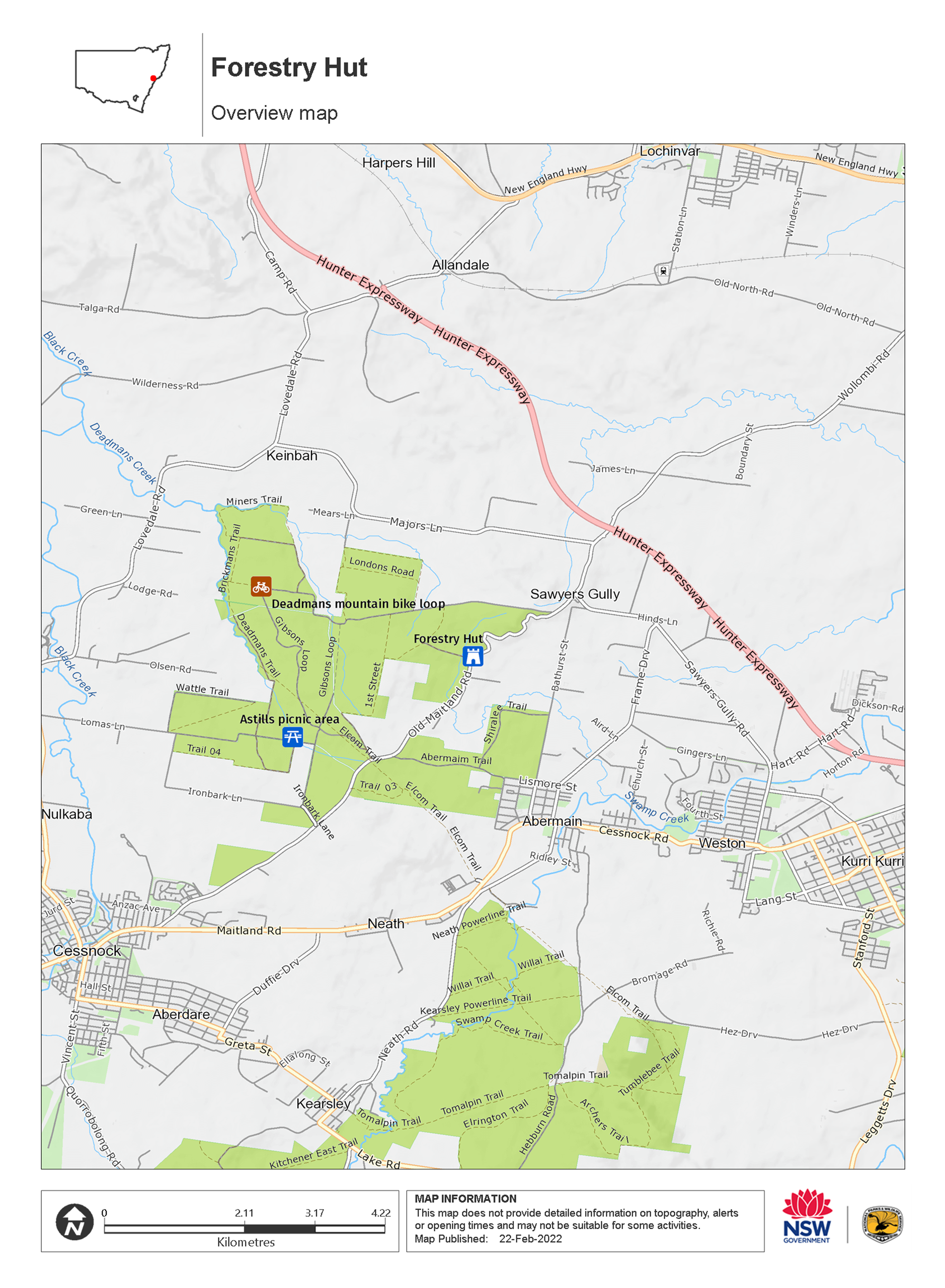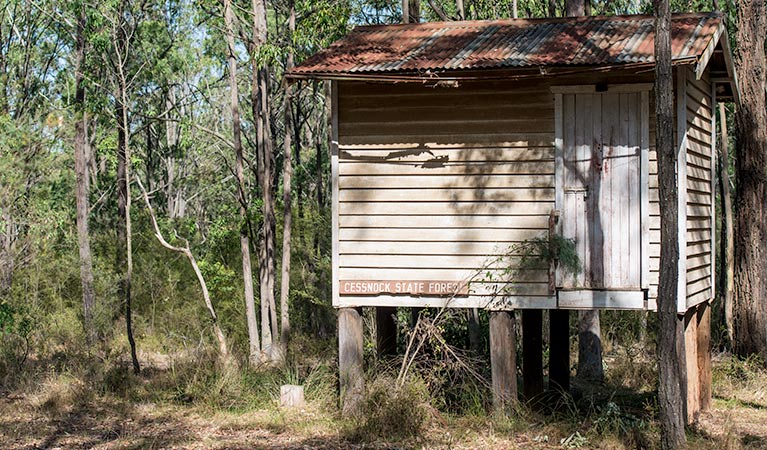Overview
If you’re heading north to Astills picnic area then you might stop for a moment to discover some historic heritage at Forestry Hut.
- Type
- Historic buildings/places
- Where
- Werakata National Park in North Coast
- Accessibility
- Hard
- What to
bring - Hat, sunscreen, drinking water
While enjoying a day exploring Werakata National Park, in Lower Hunter Valley, heritage Foresty Hut is well worth a visit. The site offers the chance to glimpse a bygone era for the park and the people who worked here.
Surrounded by tall trees, Forestry Hut is situated near Astills picnic area where you can enjoy a peaceful lunch. Bring the bikes and cycle nearby Deadmans mountain bike loop.
Huts like this were used as a base for forestry workers when the timber industry flourished. Today, the natural wonders of this park are protected and Forestry Hut is a historic reminder earlier times. As you listen to the birds in surrounding bush, imagine just how different this peaceful setting would have been many years ago. It's a good idea to take your binoculars if you want to birdwatch.
Map

Map legend

Local alerts
For the latest updates on fires, closures and other alerts in this area, see https://www.nationalparks.nsw.gov.au/things-to-do/historic-buildings-places/forestry-hut/local-alerts
General enquiries
- National Parks Contact Centre
- 7am to 7pm daily
- 1300 072 757 (13000 PARKS) for the cost of a local call within Australia excluding mobiles
- parks.info@environment.nsw.gov.au
Park info
- in Werakata National Park in the North Coast region
Werakata National Park is always open but may have to close at times due to poor weather or fire danger.
Visitor info
All the practical information you need to know about Forestry Hut.
Getting there and parking
Forestry Hut is in the northern precinct of Werakata National Park. To get there:
- From Cessnock follow Kurri Road towards Abermain
- Turn left onto Old Maitland Road
- Forestry Hut is on your left approximately 5km after the Ironbark Road turnoff
Road quality
- Unsealed roads
Vehicle access
- 2WD vehicles
Weather restrictions
- All weather
Parking
Parking is available at Forestry Hut.
Best times to visit
There are lots of great things waiting for you in Werakata National Park. Here are some of the highlights.
Autumn
The days are cooler but still sunny in autumn, making it a fabulous time for hitting the cycle trails of Werakata National Park. The Deadmans Loop trail and Astills trail offer easy flat, fun rides for the family.
Spring
There are more than 200 different types of animals recorded in Werakata National Park and the nearby State Conservation Area. Spring is a great time to see them. The wildflower displays during spring are a sight to behold .
Summer
Pack a picnic lunch and head for the Astills picnic area with its beautiful canopy of gums.
Winter
Winter is a great time for bird watching in the park. Werakata is blessed with a huge number of spotted gums, one of only a few winter-flowering eucalypts found near the New South Wales coast.
Weather, temperature and rainfall
Summer temperature
Average
18°C and 32°C
Highest recorded
44.4°C
Winter temperature
Average
5°C and 20°C
Lowest recorded
-4.2°C
Rainfall
Wettest month
February
Driest month
July
The area’s highest recorded rainfall in one day
148.8mm
Facilities
There is no mobile reception in this park.
Drinking water
Drinking water is not available in this area so it’s a good idea to bring your own.
Maps and downloads
Accessibility
Disability access level - hard
- This area can be accessed with some difficulty
Prohibited
Pets
Pets and domestic animals (other than certified assistance animals) are not permitted. Find out which regional parks allow dog walking and see the pets in parks policy for more information.
Smoking
NSW national parks are no smoking areas.
Learn more
Forestry Hut is in Werakata National Park. Here are just some of the reasons why this park is special:
Blossoming with life

Spring wildflowers such as purple happy wanderer, yellow hairpin banksia and red mountain devil all bloom in Werakata National Park. There are also delicate ground orchids and lovely thyme honey myrtle sprinkled throughout the park. More than 200 native animal species have been recorded in the park and surrounds. You'll likely see tree-dwellers like gliders, possums and bats at night. Old favourites like wallabies can also be seen feasting on the luscious landscape. Lizards, like the common scaly-foot and Burton's snake lizard, might be a little harder to find, but keep looking. If you like birds, you’ll love Werakata. The abundance of ironbark and spotted gum, which flower in winter, attracts the threatened swift parrot and regent honeyeater. The trees’ blooms are an important winter food source for the birds and the park becomes a winter breeding ground. But there is a lot of birdlife all year round. Powerful owls, masked owls, various robins, and lorikeets can all be seen here, so be sure to bring your binoculars for some great bird watching.
- Deadmans mountain bike loop Deadmans mountain bike loop is an easy 8km cycle through rare Hunter Valley bushland. The trail starts near Astills picnic area and is a good choice for a family day trip.
Green in the valley

Conservation is a vital aspect of this national park. Check out Kurri sand swamp woodland and Hunter lowlands red gum forest, as they are home to endangered ecological communities. Werakata National Park has some special and endangered plants. Over 400 species of plants are known to exist here. Lower Hunter spotted gums and ironbark form part of the park's thick bushland, and are a rich source of food for the winter birds that flock here.

